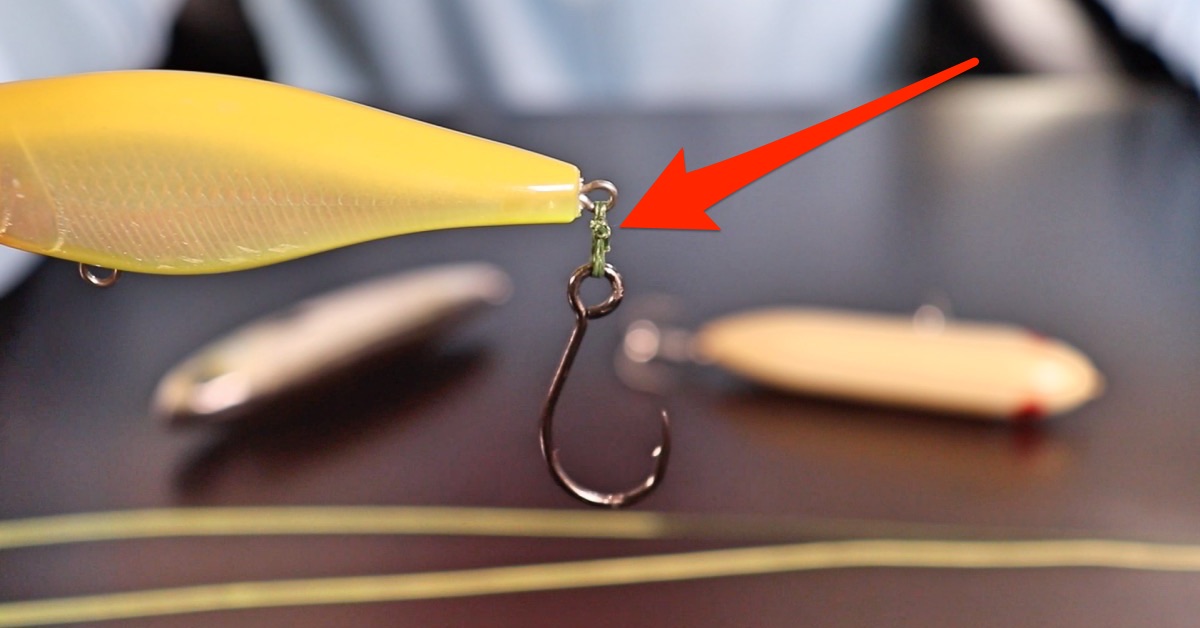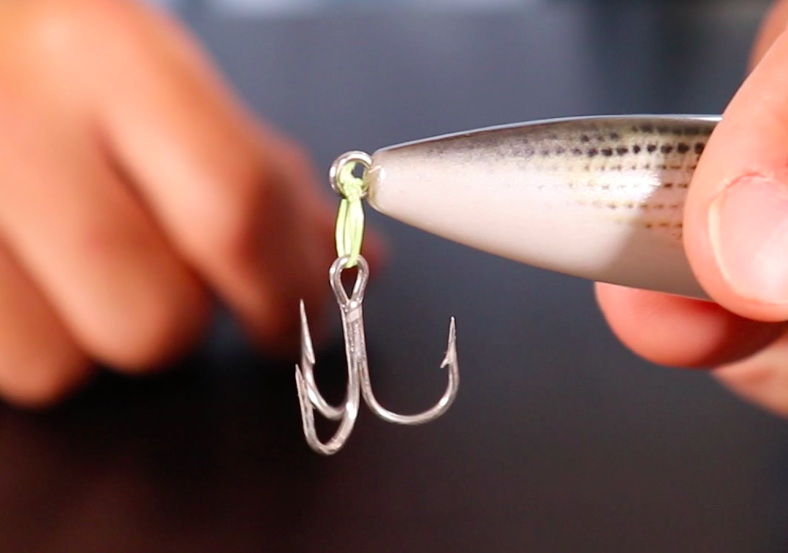How To Connect Hooks To Lures With Braided Line (And Lose Fewer Fish)
- By: Tony Acevedo
- on

When you’re fishing with hard baits and treble hooks, you might be risking losing fish without even knowing it.
Most treble hooks are attached to lures with split rings, but this type of attachment doesn’t allow for much range of motion.
If a fish spins and twists the hook, the hook can get locked up against the split ring, which could increase the chances of your fish popping off.
So, what can you do about it?
You can try attaching your hooks to your lures with braided line, instead of metal split rings.
In the video below, I’ll show exactly how to do that, plus share a little more about the potential hazards of using metal split rings.
Enjoy!
How To Tie Braided Line “Split Rings” [VIDEO]


Here’s what you’ll need to tie your own braided line “split rings”.
- scissors
- split ring pliers
- a small, round tool, like an ice pick or screwdriver
- 2 feet of 60 lb braid (at least)
Now, here’s how to do it:
Step 1: Double the braid over itself to create a loop
Step 2: Run the loop through one of the eyes on the lure and the eye of the hook
Step 3: Put the loop over itself to form another loop
Step 4: Put the tag end of the braid through the loop
Step 5: Put the screwdriver through the remaining loop and cinch the loop tight over the screwdriver
Step 6: Tie two overhand knots with the tag ends
Step 7: Cut the tag ends off
Step 8: Slide the screwdriver out
Now you have your hooks attached to the lure with braided line!
Conclusion

Although nearly all hooks are attached to hard plastic lures with split rings, you might actually land more fish if they were attached with braided line because this gives the hooks more freedom of movement.
You could tie the hooks to the lures yourself, like in the video above, but another option is to buy treble hooks with braided line eyes already made.
You can see our review of these “ready-made” hooks with braided line eyes here.
Have you tied hooks to your lures with braided line before?
Have any questions about this method?
Let me know in the comments below.
And if you know someone who would love to try this out, please TAG or SHARE this with them!
P.S. To get access to our best fishing spots, tips, and strategies, plus discounts on loads of fishing gear, click here to join us in the Insider Club.
Stop Wasting Time On The Water!
Do what the “SMART ANGLERS” are doing and join the Insider Club.
Here’s what you’ll receive today when you join:
- Weekly fishing reports and TRENDS revealing exactly where you should fish ever trip
- Weekly “spot dissection” videos that walk you through all the best spots in your area
- Exclusive fishing tips from the PROS you can’t find anywhere else
- Everything you need to start catching fish more consistently (regardless if you fish out of a boat, kayak, or land).
Click here to join today.
Related articles:
Related categories:
STOP WASTING TIME ON THE WATER!
Do what the “SMART ANGLERS” are doing and join the Insider Club.
Here’s what you’ll receive today when you join:
- Weekly fishing reports and TRENDS revealing exactly where you should fish every trip
- Weekly “spot dissection” videos that walk you through all the best spots in your area
- Exclusive fishing tips from the PROS you can’t find anywhere else
- Everything you need to start catching fish more consistently (regardless if you fish out of a boat, kayak, or land).










I’m going to try that
great idea. I was also thinking that I could make a braid loop for the twist lock hooks for quicker changes of baits. Although I have no problem with tying non slip loop knots, it does eat up a lot of leader with frequent tie on’s. I could use clips (even though I am not a big fan of those either). The clips or split rings for that manner are difficult to use with the small eyes of hooks. I thought to make the braid rings I could use a regular non-slip or kryston loop and trim off both tag ends.
Never mind. Doesn’t work that well. The thin braid can come off a clip too easily, (I only tried with the Tactical Clip, (paper clip)). I will just have to NOT change baits that often.
Yeah I try to limit how often I change out hooks and lures. I usually have 2 or 3 rods rigged up with what I plan to use for the day. I’ve also tried to get better at making the loop knot with as little amount of tag end as possible to avoid eating up a lot of leader.
I’m really glad I found this tip. I changed all my topwaters to single inline with braid and am 100% certain I’m getting better hookups than with the ring. Plus I got an unexpected additional benefit yesterday morning.
I was enjoying a particularly good morning of fishing with topwaters and had just landed another nice sized trout. This trout had both of the topwater hooks in it, and after I removed the first hook, the fish slipped out of my hand. The fish landed on the deck of my boat but on the way down the free hook quickly sliced through two of my fingers. My ring finger had hook go in through one side, out the other, then through the fingernail of my pinky, and again out through the front of the pinky. I was hooked pretty well with two fingers hooked together.
The first thing I had to do was unhook the other hook on the fish. With it still flailing around, tugging at my hooked fingers, the pain was getting pretty unpleasant. Thankfully I relatively quickly got the fish off and let him go.
Next, I had to figure out how to get the hook out of my fingers. As I was tugging at the hook to do so I realized I was in danger of hooking something else on the free hook off the topwater. I had to isolate the one hook that was in me. Thankfully, my hooks were tied on, and not on a ring that I would have to fumble with to get off. I simply cut the braid and quickly had the hook alone to deal with.
The rest of the process was pretty unpleasant. I first tugged hard and pretty inefficiently to get my pinky finger unhooked. I tore the skin a bit with that method so I decided to look online for a more efficient way to remove the rest of the hook in my ring finger. I followed the instructions in this video:
https://www.youtube.com/watch?v=aWq3uE7UuFQ
I definitely recommend this process over just a crude pull to anyone making the same stupid mistake I made. In the end, again, I credit Tony with his video which helped make this less bad of an experience for me.
Tony,
The EzeTie – 4 in 1 Knot tool (or similar) supposedly can be used to tie the main connections knots as shown here. How do these knots and technique compare to those you show?
Hey Mike,
Its hard to say because I’ve never used that tool before, but looks like it just assists in tying traditional knots, such as a uni knot, snell knot, etc. The knot I show in this video is pretty specific for this type of application.
Hey Tony,
This is something I will surely use. An additional thought, this should also serve well as a method to add an assist single hook. Just need to adjust (increase) the size of the loop and maybe go in in brand test. Thanks for sharing,
Lewis
No problem Lewis!
I have always been concerned about using trebles with Tarpon and have always preferred soft baits with a bigger J. This might alleviate my concerns about losing tarpon with trebles. I guess I’ll find out really soon!
Thx!
Can definitely help! Another issue I gave with tarpon and trebles is hooks getting bent and losing the fish that way. So I would also recommend beefing up the treble hooks.
Definitely, thanks!
Not sure if it needed or not but I took a bic lighter and melted the ends of the finished knot back and if you approach with the heat slowly it does a really nice job with the loose ends. I used 80# power pro and will keep an eye on loops to see how they hold up. Just tied 5 lures with this and can’t wait to try. Thanks Tony.
Yep that can also help! I didn’t mention it in the video so we aren’t held accountable for burnt fingers haha.
How frequently should that connection be checked/changed? I imagine the braid fatigues over time, right?
Great tip…thanks!
Hey Steve! Very often. After every strike or fish I typically check my hooks anyway to make sure they aren’t bent or anything like that. I would probably change out the braid every few trips or so just to be safe. The heavier the line, the better it should hold up.
This is an awesome tip! I was debating on using those trebles with the braid but I just don’t like how much damage they do to the fish especially since I’m a catch and release guy. Looks like I know what I’m doing this weekend in my down time!
One thought that might help. When tying the finishing half hitches, start the first knot by passing the tag end of the line over the stationary line and then the next half hitch start it by passing under the stationary line. This creates a locking figure 8 knot that won’t slip. I started doing this to finish my FG’s awhile age and haven’t had one fail since and that’s with me reeling the knot through the guides on every cast.
The nice thing about doing it on your own is you get rid of the split ring (which can fray up and damage the braid) and you can also use inline hooks. I’ll have to try that tip for the hitches. thanks Pat!
I wonder how long it will be for the Improved Tony Hook Knot to appear in the knot tying guides. I also wonder, for folks looking to tie one, if it wouldn’t make more sense to use a heavy fluorocarbon than braid since it would be more invisible.
Haha, i’m not sure the name of this knot, but I had to do quite a bit of searching to figure it out. As far as using mono or fluorocarbon, I would probably avoid that because the same lb test would be muuuuch thicker and harder to deal with when tying knots. Braid is thin, strong, and easy to work with. Not sure the visibility would be much of a factor with it being such a small piece. I would stick with green or black braid to match the hook. I used yellow in this video for visual purposes.
I might love to use a lighter test if you’re pitching a heavy treble lure around structure and it’s prone to snags. Would
Be great if you could control the presentation such that the treble hook was the weakest link if you did get snagged. If I could know I was tying a 10# treble knot to my lure but my leader was 12# I could yank on that snag and get my expensive lure back, minus one hook. But I think two overhand knots might cinch the line and reduce the line strength.